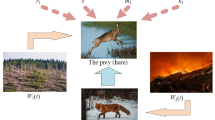Abstract
The term “Habitat Complexity” is used to measure the coupling level between different species in an ecosystem. It plays an important role to an ecosystem in which two or more species are interacting with each other. In the present paper, effects of the habitat complexity on predator–prey ecosystems with or without noise disturbances are investigated. Stochastic analysis methods of the Ito differential equations, the stochastic averaging method, and the Monte Carlo simulation are applied to obtain the stationary probability densities of the predator and prey population densities. It is found that the effects of the habitat complexity on the system dynamical behaviors are quite different for the deterministic case and the stochastic case. In absence of the noises, there are two bifurcation points dividing the level of habitat complexity into three regions: weak, moderate and strong. In the three regions, limit cycles, co-existing equilibrium states, and predator-extinct equilibrium states are present, respectively. In the stochastic case, the stable invariant measures in terms of probability distributions replace both the limit cycles and coexisting equilibriums in the regions of weak and moderate habitat complexity. For the case of strong habitat complexity, although the predator remains extinct, the prey is not in an equilibrium state, but possesses a probability distribution.










Similar content being viewed by others
References
Lotka AJ (1925) Elements of physical biology. William and Wilkins, Baltimore
Volterra V (1926) Variazioni e fluttuazioni del numero d’individui in specie d’animani conviventi. Mem Acad Lincei 2:31–113
May RM (1973) Stability and complexity in model ecosystems. Princeton University Press, Princeton, NJ
May RM (1981) Theoretical ecology, principles and applications, 2nd edn. Sinauer Associates, Sunderland
Murray JD (1993) Mathematical biology. Springer, New York
Bazykin AD (1998) Nonlinear dynamics of interacting populations. World Scientific, Singapore
Arnold L, Horthemke W, Stucki JW (1979) The influence of external real and white noise on the Lotka–Volterra model. Biom J 21:451–471
Rozenfeld AF, Tessone CJ, Albano E, Wio HS (2001) On the influence of noise on the critical and oscillatory behavior of a predator–prey model: coherent stochastic resonance at the proper frequency of the system. Phys Lett A 280:45–52
Khasminskii RZ, Klebaner FC (2001) Long term behavior of solutions of the Lotka–Volterra system under small random perturbations. Ann Appl Probab 11:952–963
Dimentberg MF (2002) Lotka–Volterra system in a random environment. Phys Rev E 65:036204
Cai GQ, Lin YK (2004) Stochastic analysis of the Lotka–Volterra model for ecosystems. Phys Rev E 70:041910
Cai GQ, Lin YK (2007) Stochastic analysis of time-delayed ecosystems. Phys Rev E 76:041913
Wu Y, Zhu WQ (2008) Stochastic analysis of a pulse-type prey–predator model. Phys Rev E 77:041911
Qi L, Cai GQ (2013) Dynamics of nonlinear ecosystems under colored noise disturbances. Nonlinear Dyn 71:463–474
Savino JF, Stein RA (1982) Predator–prey interaction between largemouth bass and bluegills as influenced by simulated, submersed vegetation. Tans Am Fish Soc 111:255–266
Alstad D (2001) Basic populas models of ecology. Prentice Hall, Englewood Cliffs
Manatunge J, Asaeda T, Priyadarshana T (2000) The influence of structural complexity on fish–zooplankton interactions: a study using artificial submerged microphytes. Environ Biol Fish 59:425–438
Grabowski JG (2004) Habitat complexity disrupts predator–prey interactions but not the trophic cascade on oyster reefs. Ecology 85:995–1004
Luckinbill L (1973) Coexistence in laboratory populations of paramecium aurelia and its predator didinium nasutum. Ecology 54:1320–1327
Bairagi N, Jana D (2011) On the stability and Hopf bifurcation of delay-induced predator–prey system with habitat complexity. Appl Math Model 35:3255–3267
Holling CS (1959) Some characteristics of some types of predation and parasitism. Can Entomol 91:385–398
Itô K (1951) On stochastic differential equations. Mem Am Math Soc 4:289–302
Lin YK, Cai GQ (2004) Probabilistic structural dynamics. McGraw Hill, New York
Ito K (1951) On a formula concerning stochastic differentials. Nagoya Math J 3:55–65
Stratonovich RL (1963) Topics in the theory of random noise, vol 1. Gordon and Breach, New York
Khasminskii RZ (1966) A limit theorem for the solution of differential equations with random right hand sides. Theory Probab Appl 11:390–405
Author information
Authors and Affiliations
Corresponding author
Rights and permissions
About this article
Cite this article
Cai, G.Q., Qi, L. Effects of habitat complexity on stochastic nonlinear ecosystems. Int. J. Dynam. Control 4, 275–283 (2016). https://doi.org/10.1007/s40435-015-0194-x
Received:
Revised:
Accepted:
Published:
Issue Date:
DOI: https://doi.org/10.1007/s40435-015-0194-x




